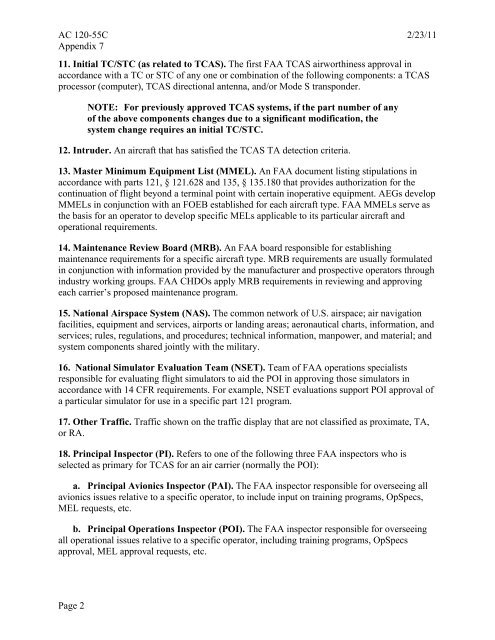AC 120-55C Air Carrier TCAS - Code7700
AC 120-55C Air Carrier TCAS - Code7700
AC 120-55C Air Carrier TCAS - Code7700
You also want an ePaper? Increase the reach of your titles
YUMPU automatically turns print PDFs into web optimized ePapers that Google loves.
<strong>AC</strong> <strong>120</strong>-<strong>55C</strong> 2/23/11Appendix 711. Initial TC/STC (as related to <strong>TCAS</strong>). The first FAA <strong>TCAS</strong> airworthiness approval inaccordance with a TC or STC of any one or combination of the following components: a <strong>TCAS</strong>processor (computer), <strong>TCAS</strong> directional antenna, and/or Mode S transponder.NOTE: For previously approved <strong>TCAS</strong> systems, if the part number of anyof the above components changes due to a significant modification, thesystem change requires an initial TC/STC.12. Intruder. An aircraft that has satisfied the <strong>TCAS</strong> TA detection criteria.13. Master Minimum Equipment List (MMEL). An FAA document listing stipulations inaccordance with parts 121, § 121.628 and 135, § 135.180 that provides authorization for thecontinuation of flight beyond a terminal point with certain inoperative equipment. AEGs developMMELs in conjunction with an FOEB established for each aircraft type. FAA MMELs serve asthe basis for an operator to develop specific MELs applicable to its particular aircraft andoperational requirements.14. Maintenance Review Board (MRB). An FAA board responsible for establishingmaintenance requirements for a specific aircraft type. MRB requirements are usually formulatedin conjunction with information provided by the manufacturer and prospective operators throughindustry working groups. FAA CHDOs apply MRB requirements in reviewing and approvingeach carrier’s proposed maintenance program.15. National <strong>Air</strong>space System (NAS). The common network of U.S. airspace; air navigationfacilities, equipment and services, airports or landing areas; aeronautical charts, information, andservices; rules, regulations, and procedures; technical information, manpower, and material; andsystem components shared jointly with the military.16. National Simulator Evaluation Team (NSET). Team of FAA operations specialistsresponsible for evaluating flight simulators to aid the POI in approving those simulators inaccordance with 14 CFR requirements. For example, NSET evaluations support POI approval ofa particular simulator for use in a specific part 121 program.17. Other Traffic. Traffic shown on the traffic display that are not classified as proximate, TA,or RA.18. Principal Inspector (PI). Refers to one of the following three FAA inspectors who isselected as primary for <strong>TCAS</strong> for an air carrier (normally the POI):a. Principal Avionics Inspector (PAI). The FAA inspector responsible for overseeing allavionics issues relative to a specific operator, to include input on training programs, OpSpecs,MEL requests, etc.b. Principal Operations Inspector (POI). The FAA inspector responsible for overseeingall operational issues relative to a specific operator, including training programs, OpSpecsapproval, MEL approval requests, etc.Page 2
















